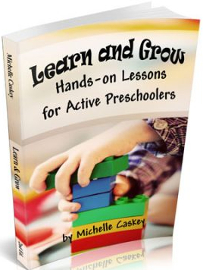Learn and Grow Hands-On Lessons for Active Preschoolers is a multi-sensory preschool program designed to be used with children as young as two years old, although the most likely audience is ages three to four.
The program teaches pre-reading skills such as the alphabet, letter recognition of both lower- and upper-case letters, and initial sounds. It also teaches numbers, counting, money, colors, shapes, fractional parts, music, art, geography, history, science, and other topics such as following directions. History, geography, and science are covered very minimally as you should expect at preschool level—children learn tidbits about those subjects that might pique their interest for future learning. Language and math skills get the most attention, and other subjects are addressed on an irregular basis, sometimes depending upon the themes.
Lessons involve both small-motor and large-motor activities so they should be good for very active children who have trouble with “sitting down” type activities. Many activities are designed specifically to develop motor skills, for example, one activity has children move grapes from one bowl to another using tongs and another has them toss ping pong balls into buckets. Because many activities require household items, and some require cooking, this program is ideal for homeschoolers.
Like many preschool programs, the letters of the alphabet provide the organizing theme. But each letter is coupled with a parallel theme that begins with the same letter of the alphabet: e.g., the letter “a” and “apples,” the letter “b” and “bubbles.” Lessons for the entire week follow the themes. There are lessons for 26 weeks with five lessons per week. I suspect that many families will choose to skip a day or two a week. That will work fine. While you can follow lessons exactly as presented, you may also pick and choose from the week’s lessons those you think most practical and useful. For children who love read-aloud books, titles of four suggested children’s picture books that relate to the theme are included with each day’s lesson.
Children become familiar with letters and sounds, they learn number recognition and counting. However, they do not learn to write other than their own name.
Lessons are presented from a 300-page book that you can purchase in either print or digital format. The digital version includes about 40 printable activity sheets in an appendix that are to be used with some of the lessons. If you buy the print edition, you can access the free companion download online for the activity sheets. The book itself is not consumable, but the companion download sheets will need to be printed for each student. (This makes it easy and inexpensive to reuse the program a number of times.)
You’ll probably want to work at least a few weeks in advance to decide which lessons you will use and gather the necessary resources. To provide all of the hands-on learning, the program uses many resources, and there are rarely days when the lesson doesn’t have a list of at least three or four resources. While they don’t tend to be expensive, they will take time to gather and prepare. Resources include craft basics such as construction paper, cardstock, markers, paint, crayons, glue, and scissors, as well as items like bean bags, apples, dishwashing liquid, glycerin, a wading pool, celery, newspapers, stickers, music CDs, rice, toothpicks, eyedroppers, and pizza boxes. Every once in a while you might run into a resource that is not readily accessible such as the “variety of bird feathers” needed for one activity—city dwellers might have trouble finding these. Planning ahead will alert you to keep an eye out for items like the bird feathers that you might want to collect while on a field trip, or pizza boxes that you might be able to salvage from a pizza party, or that wading pool that you could claim from your neighbor’s garage sale. Gathering resources and preparing lessons requires a significant amount of time. Ideally, you would be gathering resources months in advance. Then you might take some time each weekend to prep for the week’s lessons. (The prep work would be an ideal place to involve a grandparent!)
Lessons plans are very easy to follow. Each day's plan is divided into subject areas. For each area, it lists materials that are needed and any prep work that needs to be done. Then, for each subject area, there are step-by-step instructions that are simple to follow for even the novice parent or teacher. The presentation is secular, but those who want to add Bible lessons might want to use Teach Me About God, the Bible lesson companion from the same author and publisher.
Rather than a heavily academic program, Learn and Grow is a readiness program that works on skills children will need for both learning and life. They will build a foundation for learning to read and to do arithmetic while also learning life skills such as sorting and matching, how to brush their teeth, and how to recognize emotions.
While the program requires quite a bit of time to prepare and present, children are likely to enjoy the wealth of hands-on activities.










